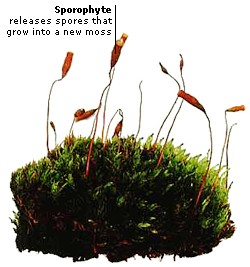DK Nature: Non Flowering Plants
Mosses, ferns, and their relatives are plants that do not produce flowers but reproduce by means of SPORES. Most live in shady or damp habitats. CONIFERS are non-flowering plants that reproduce by making seeds.
The stem, or rhizome, of a fern grows horizontally through the soil. Tiny curled-up fronds (leaves) grow from small buds on the rhizome. The buds unroll and the frond expands. The fronds of some ferns grow 20 ft (6 m) long, but others reach only 1/2 in (13 mm).
Most mosses grow in short clumps, or cushions. They do not have true roots, but short, slender growths, called rhizoids. Rootlike rhizoids anchor moss to soil, rock, or bark, but do not draw up water. Instead, leaves absorb moisture in the air.
There are 11 main phyla of non-flowering plants:
| Liverworts |
| Mosses |
| Hornworts |
| Whisk ferns |
| Club mosses |
| Horsetails |
| Ferns |
| Conifers |
| Cycads |
| Ginkgo |
| Gnetophytes. |
The last four form a group called gymnosperms—they produce seeds instead of spores.
Non-flowering plants reproduce by releasing large numbers of tiny spores. These minute organisms consist of one or a few cells inside a tough coat.
Many non-flowering plants rely on wind to carry their reproductive spores as far away as possible. This reduces competition with the parent plant for light, water, and important nutrients. If a spore lands in a damp place, it germinates (sprouts) and grows into a new plant.
Trees and shrubs whose seeds develop in woody cones are called conifers. The 550 species include pines, firs, and cedars. Conifers form dense forests in colder, northern regions. Most keep their leaves all year long.
Conifers have male and female cones. The male cones release pollen grains (male sex cells), which are blown by the wind. If pollen lands on the female cones, it fertilizes the female egg cells. The fertilized eggs develop into seeds. After one or two years, when the seeds have matured, the female cone opens up. It drops winged seeds, which germinate wherever they land.
Leaves shaped like needles help conifers survive in cold, harsh climates. The leaves are tough and coated with a waxy outer coat, or cuticle. The narrow shape, toughness, and cuticles all help the leaves withstand high winds and extreme temperatures. They also reduce water loss.
A group of plants called cycads have large seed-producing cones that can grow to more than 22 in (55 cm) long. They have sturdy trunks topped by long, divided leaves, and look more like palm trees than conifers. Cycads grow in tropical and subtropical regions. They are descended from a group of plants that flourished 250 million years ago. Today, there are 140 species of cycads.


